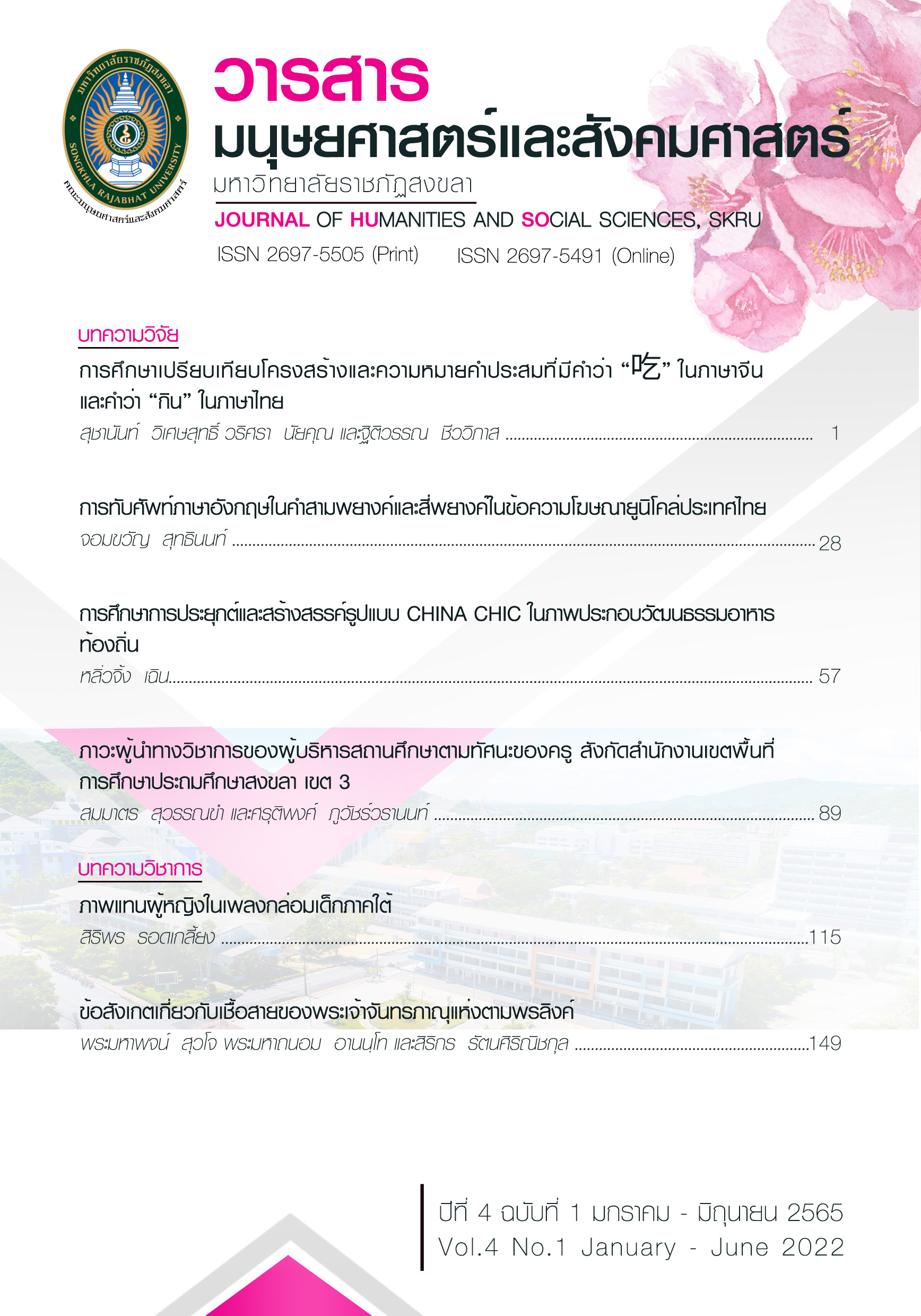SOME OBSERVATION ON LINEAGE OF KING CHANDRABANU OF TAMBRALINGA
Main Article Content
Abstract
The objective of this academic article is to study linage of King Chandrabanu of Tambralinga. This article focuses on 3 issues; 1) a descendent from Kalinga dynasty in the Malay Peninsula, 2) a descendent from the Kalinga dynasty in India and 3) a descendent from the Sri Dhammasokarat dynasty in Nakhon Si Thammarat. The result shows that a descendent of King Chandrabanu from Kalinga dynasty in the Malay Peninsula is supported by inscriptions in Sri Lanka and Thailand. A descendent from the Kalinga dynasty in India is evident in Sri Lanka’s texts and Tamil inscription. And a descendent from the Sri Dhammasokarat dynasty in Nakhon Si Thammarat is assured by Thai scholars which supported from texts and inscriptions. It is interesting to note that the name of King Chandrabanu and Sri Dhammasokarat dynasty are well-known as public names. Those do not specially mention anyone. It is known as king of southern kingdom of Thailand in ancient time.
Downloads
Article Details

This work is licensed under a Creative Commons Attribution-NonCommercial-NoDerivatives 4.0 International License.
ลิขสิทธิ
References
กรมศิลปากร. (2529). ศิลาจารึกไทย เล่ม 3. กรุงเทพฯ: ภาพพิมพ์การพิมพ์.
กรมศิลปากร. (2529). ศิลาจารึกไทย เล่ม 5. กรุงเทพฯ: ภาพพิมพ์การพิมพ์.
ขจร สุขพานิช. (2521). ราชวงศ์ศรีธรรมโศกราช. ประวัติศาสตร์และโบราณคดีนครศรีธรรมราช. พระนคร: วิทยาลัยครูนครศรีธรรมราช.
คงเดช ประพัฒน์ทอง. (2529). โบราณคดีประวัติศาสตร์. กรุงเทพฯ: รุ่งศิลป์การพิมพ์ (1977).
เฉลิม ยงบุญเกิด. (2505). ไทยในบันทึกของจีน. วารสารศิลปากร, 7(2), น. 28-32.
ตำนานพระธาตุเมืองนครศรีธรรมราช. (2471). พิมพ์ในงานปลงศพนางเทพนรินทร (สงวน อิศรางกูร ณ อยุธยา) พิมพ์ที่โรงพิมพ์โสภณพิพรรฒธนากร เมื่อปีมะโรง พ.ศ.2471.
ประทีป ชุมพล. (2536). นครศรีธรรมราช: ตำนานโบราณคดีและประวัติศาสตร์. กรุงเทพฯ: สำนักพิมพ์อาทิตย์.
ประทุม ชุ่มเพ็งพันธุ์. (2523). ตามพรลิงค์. (วิทยานิพนธ์ปริญญามหาบัณฑิต). กรุงเทพฯ: มหาวิทยาลัยศิลปากร.
ประเสริฐ ณ นคร. (2525). อักษร ภาษา และจารึกสมัยศรีวิชัย. ในรายงานการสัมมนาประวัติศาสตร์-โบราณคดีศรีวิชัย ณ จังหวัดสุราษฎร์ธานี. (น.157-170). กรุงเทพฯ: พิฆเณศการพิมพ์.
พิริยะ ไกรฤกษ์. (2520). แบบศิลปะในประเทศไทย. กรุงเทพฯ: สำนักพิมพ์อมรินทร์.
พระพุทธพุกามเถระและพระพุทธญาณเถระ. (2557). ตำนานมูลศาสนา. (ร.ต.ท. แสง มนวิทูร, ผู้แปล). กรุงเทพฯ: ศรีปัญญา.
พระโพธิรังษีเถระ. (2554). นิทานพระพุทธสิหิงค์. กรุงเทพฯ: ศรีปัญญา.
พระรัตนปัญญาเถระ. (2515). ชินกาลมาลีปกรณ์. (ร.ต.ท. แสง มนวิทูร, ผู้แปล). กรุงเทพฯ: กรมศิลปากร.
มานิต วัลลิโภดม. (2530). ทักษิณรัฐ. กรุงเทพฯ: รุ่งศิลป์การพิมพ์.
เรื่องเมืองนครศรีธรรมราช. (2510). พิมพ์เป็นอนุสรณ์ในงานฌาปนกิจศพ นางตลับ จันทราทิพย์ ณ ฌาปนสถานกองทัพบก วัดโสมนัสวิหาร วันที่ 19 ธันวาคม 2510.
ลังกากุมาร. (2562). ศรีลังกากติกาวัตร: ว่าด้วยระเบียบข้อบังคับเพื่อความดีงามของหมู่คณะ. นครปฐม: สาลพิมพการ.
วิเชียร ณ นคร, สมพุทธ ธุระเจน, ชวน เพชรแก้ว, ฉัตรชัย ศุภระกาญจน์, และปรีชา นุ่นสุข. (2521). นครศรีธรรมราช. กรุงเทพฯ: อักษรสัมพันธ์การพิมพ์.
วินัย พงศ์ศรีเพียร (บรรณาธิการ). (2554). สรรพสาระประวัติศาสตร์ไทย ลำดับที่ 10 : เอกสารเกี่ยวกับประวัติศาสตร์ภาคใต้และบันทึกราชทูตของออกพระวิสุทธิสุนทร. กรุงเทพฯ: สำนักงานกองทุนสนับสนุนการวิจัย (สกว).
สุธิวงศ์ พงศ์ไพบูลย์. (2524). พระพุทธศาสนาแถบลุ่มทะเลสาบสงขลาฝั่งตะวันออก สมัยกรุงศรีอยุธยา. สงขลา: สถาบันทักษิณคดีศึกษา มหาวิทยาลัยศรีนครินทรวิโรฒ.
อมรา ศรีสุชาติ. (2557). ศรีวิชัยในสุวรรณทวีป. กรุงเทพฯ: กรมศิลปากร.
Chand Chirayu Rajani, M. C. (1975). Background to the Sri Vijaya Story-Part III. The Journal of Siam Society. 63(1), p. 208-256.
Codrington, H. W. (1994). A Short History of Ceylon. New Delhi: Asian Educational Services.
Das, M. N. (Eds.). (1977). Sidelights on History and Culture of Orissa. New Delhi: Vidyapuri.
De Silva, C. R. (2001). Sri Lanka: A History. New Delhi: Vikas Publishing House.
Geiger W. (1992). Culavamsa 2 parts. New Delhi: Asian Educational Services.
Godakumbura, C. E. (1956). Hatthavanagallaviharavamsa. London: Pali Buddhist Society.
Hall, D. G. E. (1955). A History of South-East Asia. London: Macmillan.
Indrapala, K. (1965). Dravidian Settlement in Ceylon and the Beginnings of the Kingdom of Jaffna. (Doctoral dissertation). London: University of London.
Liyanagamage, A. (2018). The Decline of Polonnaruva and the Rise of Dambadeniya. Colombo: S.Godage & Brothers (Pvt).
Nicholas, C. W. (1961). A Concise History of Ceylon. Colombo: Ceylon University Press.
Paranatitana, S. (1966). Ceylon and Malaysia. Colombo: Lake House Investment.
Paranavitana, S. (1994). Epigraphia Zeylanica. vol. iv. New Delhi: Asian Educational Services.
Sastri, K.A.N. (1937). The Ceylon Expedition of Jatavarman Vira Pandya. Proceedings and Transactions of the Eighth All-India Oriental Conference Mysore. (p. 152-169). Bangalore: The Government Press.
Singh, D. (1973). The History of the Eastern Ganga Dynasty Circa 1038-1238 A.D. (Doctoral dissertation). London: University of London.
Sirisena, W. M. (1971). The Kalinga Dynasty of Ceylon and the Theory of its South-East Asian Origin. The Ceyon Journal of Historical and Social Studies. New Series, vol.1, (Jan-Jun).
Sirisena, W. M. (2016). Sri Lanka and South-East Asia. Sri Lanka: Chatura Printers.
Sradhatisya, B. (1930). Pujavaliya. Panadura: Colombo: Ceylon.
Tennakoon, R. (1954). Elu-Attanagaluvamsaya. Colombo: Ceylon.
Wickremasinghe, D. D. Z. (1985). Epigraphia Zeylanica. vol. ii. London: Oxford University Press.
Wickramasinghe, S. (1956). The Kalinga Period of Ceylon History (1186 A.D.-1235 A.D.). (Master of Arts thesis). Kandy: University of Ceylon.


